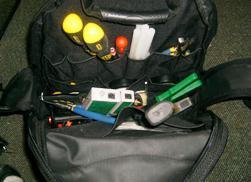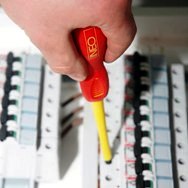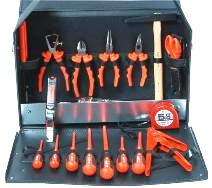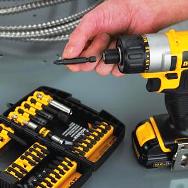Categories: Electrician at home, About electricians and not only
Number of views: 43292
Comments on the article: 1
Electrical tool
 Quite often you have to observe the work of electricians, who, how and with what tool works. And sometimes you see a woe-electrician with a tool that can only, except that, hammer nails and poke around the walls ... After all, electricians are the intelligentsia among builders, white bone, so to speak ...
Quite often you have to observe the work of electricians, who, how and with what tool works. And sometimes you see a woe-electrician with a tool that can only, except that, hammer nails and poke around the walls ... After all, electricians are the intelligentsia among builders, white bone, so to speak ...
In this article, we will try to “assemble” an electrician’s suitcase, which we will equip with the most necessary electric installation tool that every self-respecting electrician uses in everyday practice.
So, the choice of an electrical installation tool for work is purely individual, but there is a universal set that is necessary for daily work. The following tools can be safely added to this set:
Pliers, To many, this tool is known as Passing. There are relatively few varieties of this tool, they differ, pliers, only in functionality.
Side cutting pliersThe tool is better known as side cutters. The principle of all "nippers" is the same. They vary in size, according to the bite of the cutting edge.
Round pliers.
Electric knife. There are ready-made, universal knives for electricians, but almost all electricians-professionals use homemade knivesmade from rapier saw blade. These knives are customized individually for themselves, they are more reliable in operation, not so dull quickly.
 Set of screwdrivers. The set should have Phillips and flat-head screwdrivers, or a slot, as they are also called. You must have a complete set. It is best to purchase a screwdriver from well-known companies. Screwdriver handles should be made of good dielectric. A good tool, for electricians, usually has a stigma of up to 1000 V. There are also screwdrivers with magnetized tips, which greatly simplifies the work when performing some operations.
Set of screwdrivers. The set should have Phillips and flat-head screwdrivers, or a slot, as they are also called. You must have a complete set. It is best to purchase a screwdriver from well-known companies. Screwdriver handles should be made of good dielectric. A good tool, for electricians, usually has a stigma of up to 1000 V. There are also screwdrivers with magnetized tips, which greatly simplifies the work when performing some operations.
Stripping tool - stripper. Allows you to remove insulation from wires with a diameter of 0.5 mm square to 6 mm square in a semi-automatic mode. There have been a lot of varieties of this device lately, but the principle of operation is almost the same for everyone, one of the most common names for a domestic device is SI-1, SI-3.2, etc.
 It is convenient and rational to use the device for removing insulation in such jobs where it is necessary to strip relatively many wires - assembling large panels, streaming installation of accessories (sockets, switches, lamps). And again, this wiring tool is not for everybody. Using this device, not everywhere you can "crawl", given its size.
It is convenient and rational to use the device for removing insulation in such jobs where it is necessary to strip relatively many wires - assembling large panels, streaming installation of accessories (sockets, switches, lamps). And again, this wiring tool is not for everybody. Using this device, not everywhere you can "crawl", given its size.
Voltage indicators. Each professional electrician has, as a rule, several indicators. After all, your life depends on how you correctly and accurately determine the presence or absence of tension.
Simplest voltage indicator - indicator screwdriver, assembled on a neon bulb and resistance. It is also necessary to have bipolar voltage indicators available. It shows a more complete picture of the presence or absence of tension. In addition, there are bipolar voltage indicators that also show the voltage rating.
Also, almost all professional electricians should have measuring pliers. Today there are combined multimers. These devices are universal. Using such devices, you can measure voltage, current, resistance, etc.
Choosing a wiring tool, do not forget about hammer. When choosing a hammer, pay attention to the handle, the shape of the hammer (iron part), its weight. Do not take a hammer with a wooden handle.By the weight of the hammer, the most optimal is 500 grams.
 Boaster. Those who are involved in electrical work know what it is. Scarpel is essentially a chisel. But it is designed for general construction work, for work on stone, brick, concrete. Apply it where there is no possibility to use hammer drill and another electric tool.
Boaster. Those who are involved in electrical work know what it is. Scarpel is essentially a chisel. But it is designed for general construction work, for work on stone, brick, concrete. Apply it where there is no possibility to use hammer drill and another electric tool.
Further. Each electrician in a set of electrical tools must have soldering iron. Ideally, there should be several for different types of work. But if you are professionally involved in electrical work, then for you the ideal solution would be to have gas soldering iron burner.
Use such a soldering iron for soldering, tinning copper wires. If you have some experience using a gas soldering iron - a torch, you will greatly facilitate your work and improve the quality of work performed.
Crimping pliers, press pliers. Use such a tool for crimping tips, sleeves, various connectors. For crimping tips and sleeves with a size of 6 mm kV and above, the use of a hydraulic press is more convenient. But if you do not use this tool in everyday practice, then it is more reasonable to rent such an electrical installation tool.
In addition to all of the above, you should always have at hand: insulating tape, preferably in different colors. marker, for marking wires, cables, etc., terminal blocks of different sizes and types, cable ties and other consumables.
Here, perhaps, is the minimum wiring tool that you need to have in your bag.
Sergey Seromashenko
Electrical engineering and electronics for beginners, electrical work,electrician in the apartment, do-it-yourself electrician.
See also at i.electricianexp.com
:
